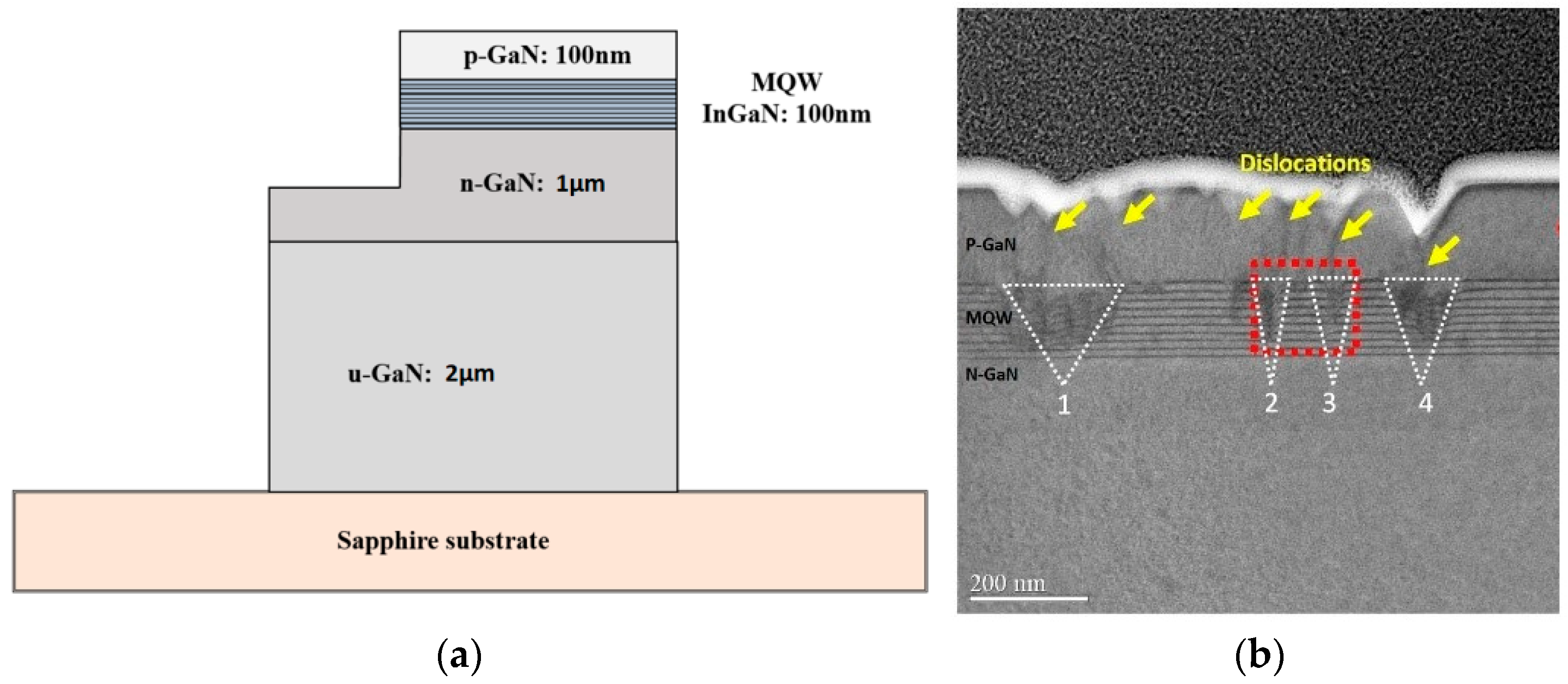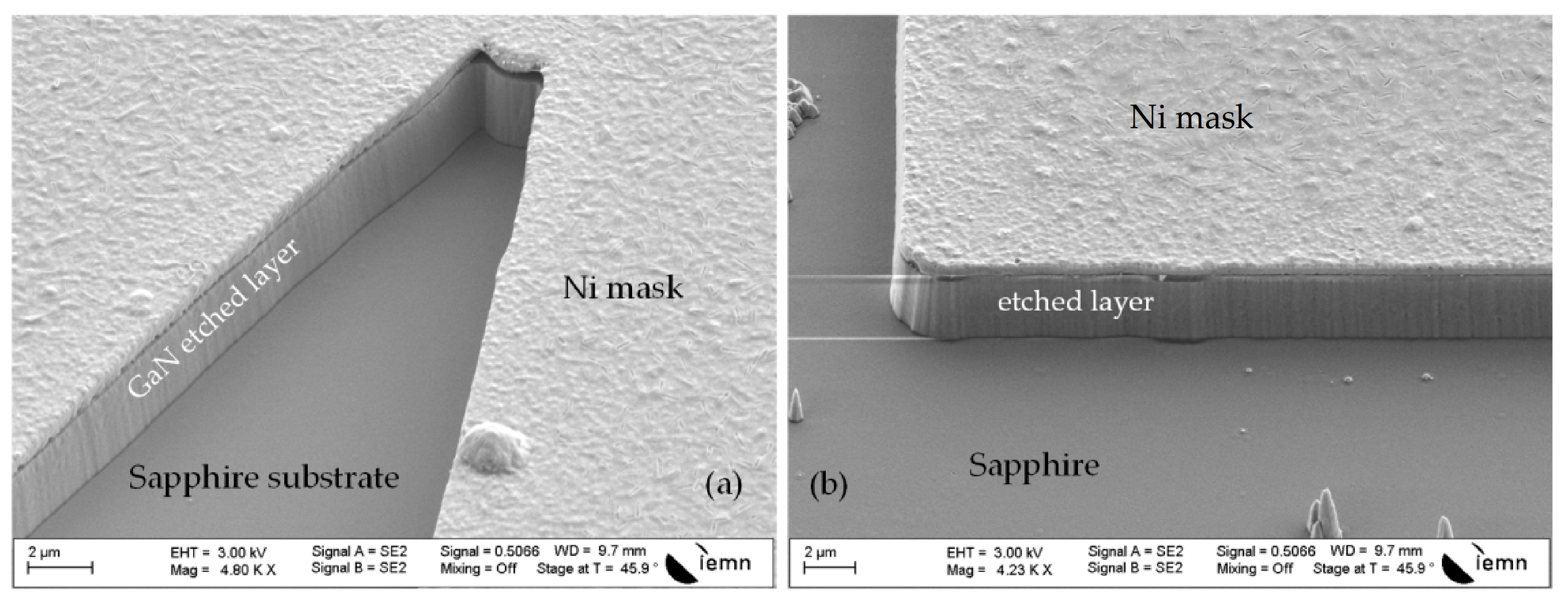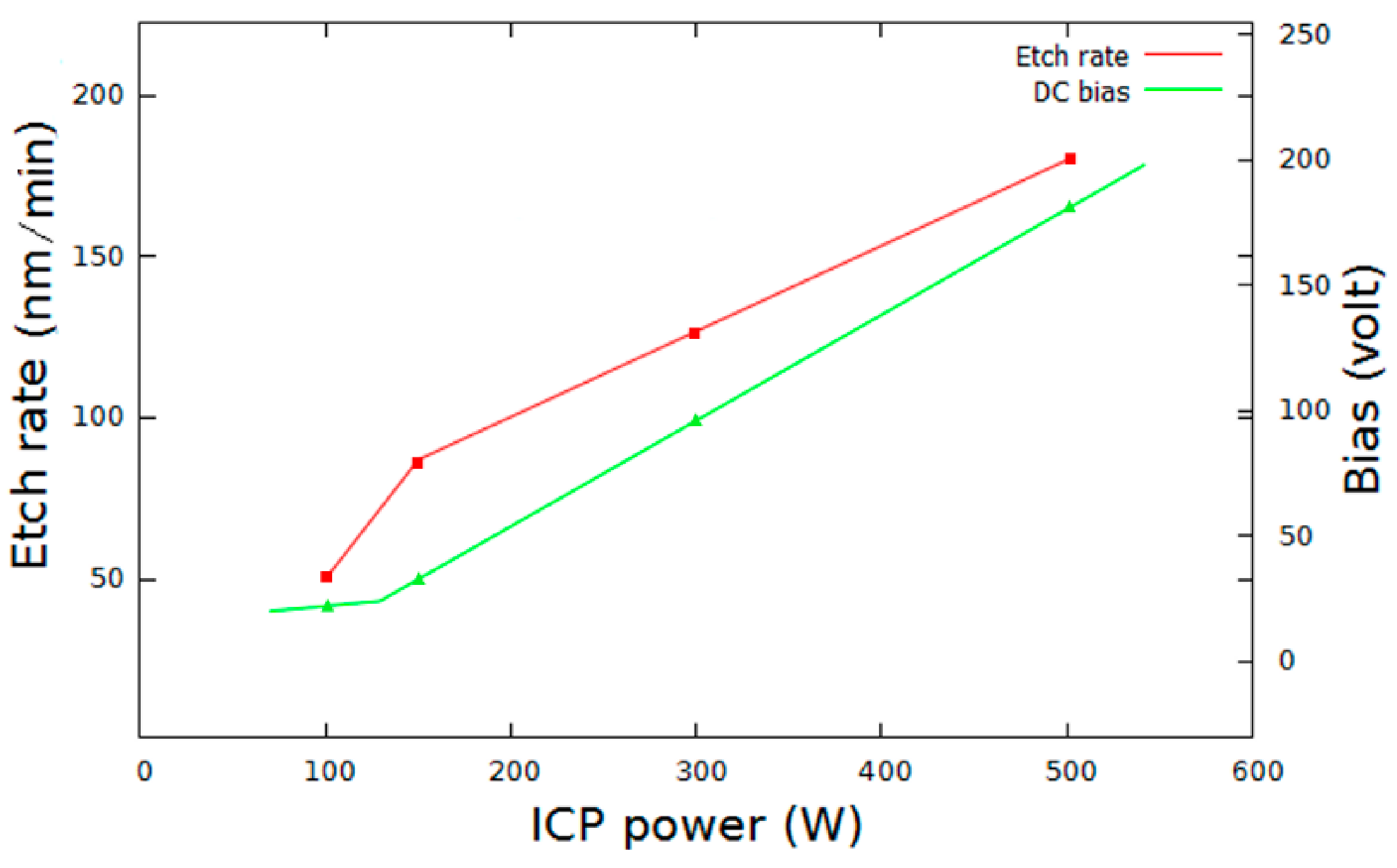Development of Micron Sized Photonic Devices Based on Deep GaN Etching
Abstract
:1. Introduction
2. Experimental Details
3. Results and Discussion
4. Conclusions
Author Contributions
Funding
Data Availability Statement
Acknowledgments
Conflicts of Interest
References
- Li, X.; Jiang, Y.; Li, J.; Shi, Z.; Zhu, G.; Wang, Y. Integrated photonics chip with InGaN/GaN light-emitting diode and bended waveguide for visible-light communicacations. Opt. Laser Technol. 2019, 114, 103–109. [Google Scholar] [CrossRef]
- Zhou, S.; Wang, S.; Liu, S.; Ding, H. High power GaN-based LEDs with low optical loss electrode structure. Opt. Laser Technol. 2013, 54, 321–325. [Google Scholar] [CrossRef]
- Li, K.H.; Fu, W.Y.; Cheung, Y.F.; Wong, K.K.Y.; Wang, Y.; Lau, K.M.; Choi, H.W. Monolithically integrated InGaN/GaN light-emitting diodes, photodetectors, and waveguides on Si substrate. Optica 2018, 5, 564. [Google Scholar] [CrossRef]
- Nakamura, S. InGaN-Based laser diodes. Annu. Rev. Mater. Sci. 1998, 28, 125–152. [Google Scholar] [CrossRef]
- Omnès, F.; Monroy, E.; Muñoz, E.; Reverchon, J.-L. Wide bandgap UV photodetectors: A short review of devices and applications. SPIE 2007, 6473, 64730E. [Google Scholar]
- Lee, K.H.; Joo, D.H.; Kim, M.S.; Yu, J.S. Improved light extraction of InGaN/GaN blue LEDs by GaOOH NRAs using a thin ATO seed layer. Nanoscale Res. Lett. 2012, 7, 458. [Google Scholar] [CrossRef] [Green Version]
- Khokhar, A.Z.; Parsons, K.; Hubbard, G.; Rahman, F.; Macintyre, D.S.; Xiong, C.; Massoubre, D.; Gong, Z.; Johnson, N.P.; De La Rue, R.M.; et al. Nanofabrication of gallium nitride photonic crystal light-emitting diodes. Microelectron. Eng. 2010, 87, 2200–2207. [Google Scholar] [CrossRef] [Green Version]
- Hong, S.; Cho, C.; Lee, S.; Yim, S.; Lim, W.; Kim, S.; Park, S. Localized surface plasmon-enhanced near-ultraviolet emission from InGaN/GaN light-emitting diodes using silver and platinum nanoparticles. Opt. Express 2013, 21, 3138–3144. [Google Scholar] [CrossRef] [PubMed]
- Baik, K.H.; Pearton, S.J. Dry etching characteristics of GaN for blue/green light-emitting diode fabrication. Appl. Surf. Sci. 2009, 255, 5948–5951. [Google Scholar] [CrossRef]
- Zhang, Y.; Sun, M.; Piedra, D.; Azize, M.; Zhang, X.; Fujishima, T.; Palacios, T. GaN-on-Si vertical schottky and p-n diodes. IEEE Electron. Dev. Lett. 2014, 35, 618–620. [Google Scholar]
- Hu, J.; Zhang, Y.; Sun, M.; Piedra, D.; Chowdhury, N.; Palacios, T. Materials and processing issues in vertical GaN power electronics. Mater. Sci. Semicond. Proc. 2018, 78, 75–84. [Google Scholar] [CrossRef] [Green Version]
- Tohru, O. Recent development of vertical GaN power devices: Japanese. J. Appl. Phys. 2019, 58, SB0805. [Google Scholar]
- Xiao, M.; Yan, X.; Xie, J.; Beam, E.; Cao, Y.; Wang, H.; Zhang, Y. Origin of leakage current in vertical GaN devices with nonplanar regrown p-GaN. Appl. Phys. Lett. 2020, 117, 183502. [Google Scholar] [CrossRef]
- Sun, Y.; Kang, X.; Zheng, Y.; Lu, J.; Tian, X.; Wei, K.; Wu, H.; Wang, W.; Liu, X.; Zhang, G. Review of the Recent Progress on GaN-Based Vertical Power Schottky Barrier Diodes (SBDs). Electronics 2019, 8, 575. [Google Scholar] [CrossRef] [Green Version]
- Hsieh, Y.; Chen, W.; Chang, L.; Chow, L.; Borges, S.; Schulte, J.A.; Huang, S.; Jeng, M.; Yu, C. Etched Gallium Nitride Waveguide for RamanSpectroscopic Applications. Crystals 2019, 9, 176. [Google Scholar] [CrossRef] [Green Version]
- Qiu, R.; Lu, H.; Chen, D.; Zhang, R.; Zheng, Y. Optimization of inductively coupled plasma deep etching of GaN and etching damage analysis. Appl. Surf. Sci. 2011, 257, 2700. [Google Scholar] [CrossRef]
- le Boulbar, E.D.; Lewins, C.J.; Allsopp, D.W.E.; Bowen, C.R.; Shields, P.A. Fabrication of high-aspect ratio GaN nanostructures nanostructures for advanced photonic devices. Microelectron. Eng. 2016, 153, 132–136. [Google Scholar] [CrossRef] [Green Version]
- Okada, N.; Nojima, K.; Ishibashi, N.; Nagatoshi, K.; Itagaki, N.; Inomoto, R.; Motoyama, S.; Kobayashi, T.; Tadatomo, K. Formation of distinctive structures of GaN by inductively-coupled-plasma and reactive ion etching under optimized chemical etching conditions. AIP Adv. 2017, 7, 065111. [Google Scholar] [CrossRef] [Green Version]
- Jeon, C.W.; Choi, H.W.; Dawson, M.D. Fabrication of Matrix-Addressable InGaN-Based Microdisplays of High Array Density. IEEE Photonics Technol. Lett. 2003, 15, 1516–1518. [Google Scholar] [CrossRef]
- Wu, X.H.; Elsass, C.R.; Abare, A.; MacK, M.; Keller, S.; Petroff, P.M.; Denbaars, S.P.; Speck, J.S.; Rosner, S.J. Structural origin of V-defects and correlation with localized excitonic centers in InGaN/GaN multiple quantum wells. Appl. Phys. Lett. 1998, 72, 692–694. [Google Scholar] [CrossRef]
- Lester, S.D.; Ponce, F.A.; Craford, M.G.; Steigerwald, D.A. High dislocation densities in high efficiency GaN-based light-emitting diodes. Appl. Phys. Lett. 1995, 66, 1249–1251. [Google Scholar] [CrossRef]
- Kim, I.H.; Park, H.S.; Park, Y.J.; Kim, T. Formation of V-shaped pits in InGaN/GaN multiquantum wells and bulk InGaN films. Appl. Phys. Lett. 1998, 73, 1634–1636. [Google Scholar] [CrossRef]
- Yang, G.F.; Chen, P.; Wu, Z.L.; Yu, Z.G.; Zhao, H.; Liu, B.; Hua, X.M.; Xie, Z.L.; Xiu, X.Q.; Han, P. Characteristics of GaN thin films by inductively coupled plasma etching with Cl2/BCl3 and Cl2/Ar. J. Mater. Sci. Mater. Electron. 2012, 23, 1224–1228. [Google Scholar] [CrossRef]
- Cho, H.; Hahn, Y.B.; Hays, D.C.; Jung, K.B.; Donovan, S.M.; Abernathy, C.R.; Pearton, S.J.; Shul, R.J. Inductively Coupled Plasma Etching of III-Nitrides in Cl2/Xe, Cl2/Ar and Cl2/He. Mater. Res. Soc. Internet J. Nitride Semicond. Res. 1999, 4, 763–768. [Google Scholar] [CrossRef] [Green Version]
- Rawal, D.; Arora, H.; Sehgal, B.; Muralidharan, R. Comparative study of GaN mesa etch characteristics in Cl2 based inductively coupled plasma with Ar and BCl3 as additive gases. J. Vacuum Sci. Technol. A 2014, 32, 031301. [Google Scholar] [CrossRef]
- Kim, H.K.; Lin, H.; Ra, Y. Etching mechanism of a GaN/InGaN/GaN heterostructure in Cl2 and CH4 based inductively coupled plasmas. J. Vac. Sci. Technol. A 2004, 22, 598–601. [Google Scholar] [CrossRef]
- Lai, Y.; Yeh, C.; Wang, J.; Wang, H.H.; Chen, C.; Hung, W. Sputtering and Etching of GaN Surfaces. J. Phys. Chem. B 2001, 105, 10029–10036. [Google Scholar] [CrossRef]
- Ladroue, J.; Meritan, A.; Boufnichel, M.; Lefaucheux, P.; Ranson, P.; Dussart, R. Deep GaN etching by inductively coupled plasma and induced surface defects. J. Vac. Sci. Technol. A 2010, 28, 1226. [Google Scholar] [CrossRef]
- Evgeny, Z.; Sergei, S.; Alan, G.; Wang, W.N.; Shreter, Y.G.; Tarkhin, D.V.; Bochkareva, N.I. ICP etching of III-nitride based laser structure with Cl2–Ar plasma assisted by Si coverplate material. J. Vac. Sci. Technol. A 2005, 23, 687–692. [Google Scholar]
- Lee, H.; Harris, J. Iron nitride mask and reactive ion etching of GaN films. J. Electron. Mater. 1998, 27, 185–189. [Google Scholar] [CrossRef]





Publisher’s Note: MDPI stays neutral with regard to jurisdictional claims in published maps and institutional affiliations. |
© 2021 by the authors. Licensee MDPI, Basel, Switzerland. This article is an open access article distributed under the terms and conditions of the Creative Commons Attribution (CC BY) license (http://creativecommons.org/licenses/by/4.0/).
Share and Cite
Dogheche, K.; Alshehri, B.; Patriache, G.; Dogheche, E. Development of Micron Sized Photonic Devices Based on Deep GaN Etching. Photonics 2021, 8, 68. https://doi.org/10.3390/photonics8030068
Dogheche K, Alshehri B, Patriache G, Dogheche E. Development of Micron Sized Photonic Devices Based on Deep GaN Etching. Photonics. 2021; 8(3):68. https://doi.org/10.3390/photonics8030068
Chicago/Turabian StyleDogheche, Karim, Bandar Alshehri, Galles Patriache, and Elhadj Dogheche. 2021. "Development of Micron Sized Photonic Devices Based on Deep GaN Etching" Photonics 8, no. 3: 68. https://doi.org/10.3390/photonics8030068
APA StyleDogheche, K., Alshehri, B., Patriache, G., & Dogheche, E. (2021). Development of Micron Sized Photonic Devices Based on Deep GaN Etching. Photonics, 8(3), 68. https://doi.org/10.3390/photonics8030068





